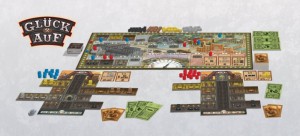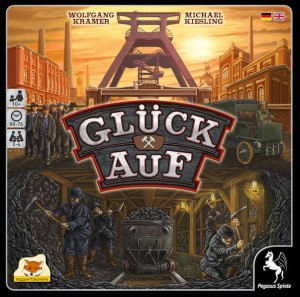Spiel 2013 Preview: Glück Auf
Posted by James (admin) on October 9th, 2013

Wolfgang Kramer and Michael Kiesling have an impressive track record in their design partnership with games like the excellent Palaces of Carrara, Tikal, Tikal II, Torres and Asara. In fact, Kramer has won the Spiel des Jahres 5 times (twice with Kiesling). So, I’m always interested in any game they create.
Glück Auf is a worker-placement mining game. Each player has their own mine which has 4 levels (each providing a different type of coal) and a lift shaft down the centre. The coal trucks you buy during the game must be placed on the matching level and they must also be placed on one side of the lift shaft of the tunnels they are in are torch-lit, or placed on the other if their tunnels are dark.
In the centre of the table is the main board where players place their workers to (a) gain coal orders, (b) gain cash, (c) buy mine trucks (which start coal filled in the relevant mine level), (d) gain movement points (which are used to move the coal and the lift to get the coal to the surface), and (e) deliver completed orders. The action spaces for delivering orders allow a player to deliver any completed orders that match the action space’s transport method, i.e. a player using the delivery action space showing a train can deliver any complete orders they have with a train on them.
From the rules, the game seems fairly straight forwards with players using their workers; however, Glück Auf has a few subtle differences to other worker placement games which I think will give it its own character. First is that players take turns placing workers and they get to use the relevant action as soon as they place workers on an action space. If a space is empty, the player must place 1 worker on it; however, a player can place workers on an occupied action space by placing a number of workers equal to the number currently occupying the action space plus one more (which displaces the workers to the canteen where they stay until the end of the shift). So, 2 workers can displace 1 worker, then 3 workers could displace those 2, and so on. Therefore, you need to work out how to get the most out of your workers, with the humorous potential for making some action spaces too expensive for other players too.

When all players have no workers left to use, the shift ends and scoring takes place. The game ends after 3 shifts. However, scoring is also a bit different: There are 3 groups of scoring elements. After the 1st shift only the 1st group of scoring elements is assessed; after the 2nd shift the 1st and 2nd group of scoring elements are assessed; and, after the 3rd shift all 3 groups of scoring elements are assessed. Scoring elements are based on having the most and second-most of different things, like having delivered the most grey coal, having made the most deliveries made by train, having the most empty yellow coal trucks.
Also, there are some extra points to be earned and lost at the very end of the game too, including losing points for not having a mine that is balanced on both sides of the elevator shaft.
So, Glück Auf seems to be a relatively simple worker placement with some subtle new approaches which I think make it look very interesting indeed.
You can read the rules and see the details of the game on Eggertspiele’s web site: bga.me/GluckAuf
James.

